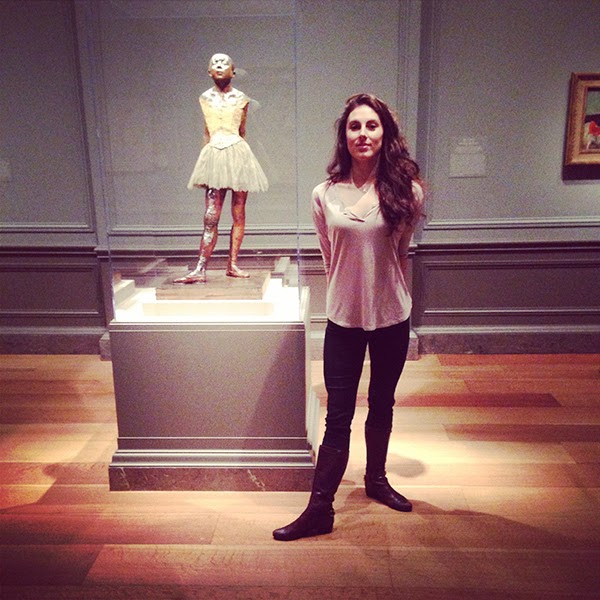 |
| overall without base: 98.9 x 34.7 x 35.2 cm (38 15/16 x 13 11/16 x 13 7/8 in.) weight: 49 lb. (22.226 kg) National Gallery of Art, Washington, Collection of Mr. and Mrs. Paul Mellon |
It was a joy to see the Kennedy Center's world-premiere production, The Little Dancer, which closed on November 30th. Tiler Peck, principle of the New York City Ballet had the lead as 14-year-old Marie van Goethem, the ballerina who posed for Degas' famous statue, Little Dancer. Although Peck is definitely far more mature than Degas' model was, she certainly was a good choice for the role. Boyd Gaines, as Degas, really does not look like him but I guess it doesn't matter. Some of the settings and compositions are the same as you will see in his paintings. (My blog about Degas's paintings of dancers)
|
 |
| Tiler Peck in front of the National Gallery of Art's Little Dancer Aged Fourteen , from Tiler Talks Blog, October 15, 2014 |
The story is truthful in that portrayed some of the challenges in the lives of the dancers who were working class girls. Marie's mother was a laundress, and I'm guessing she posed for Degas, too. Laundresses -- like dancers and race horses -- were part of Degas' continuous subject matter, as he studied the movements of muscles and limbs at work and in stress. (While we think of dancers and race horses expressing consummate grace, we don't think of laundresses that way.) In the play, Marie was put into a competition with snooty, upper class girl who had a stage mother, a story for a Disney movie or a story which would be more truthful today. Wealthy girls were not so likely to be ballerinas in the 19th century, as their parents wouldn't have subjected them to gawking men. Class differences, as a major theme of the play, are historically correct for the time. Other details of biography, Degas' grumpy outer shell that hid his softness, his sensitivity to strong light and fear of going blind were woven into the tale. Of course, the close companionship and artistic relationship with Mary Cassatt, especially during the time Marie would have posed, were very true.
 |
| Tiler Peck as Marie, the Little Dancer, in the Kennedy Center Musical of that name |
For the importance of the statue artistically, the National Gallery of Art will have Little Dancer Aged Fourteen on display in an exhibition with other sketches, paintings and sculpture until January 11, 2015. I think the importance of Degas' wax sculptures as comparable the importance of his sketches. Waxes to bronzes are like drawings are to paintings, although not necessarily the case here. It helped him realize his vision for his paintings.
Degas built the statue in wax over an armature, and he did it in an additive process. In the play, it is called a "characterizing portrait." and As such, it was quite innovative. Details are not the important part as much as the essence the characterization. The play opens with a famous by Degas: "Art is not what you see, but what you make others see." What Degas did so brilliantly make us see the essence of the practice, the work, the attitude and the dedication which made the ballet become what it became. Most of his paintings are of rehearsals rather than performances. Seeing his work makes our lives richer, and seeing "Little Dancer" enriches us. Even the 6-year old boys near me were entranced by it.
